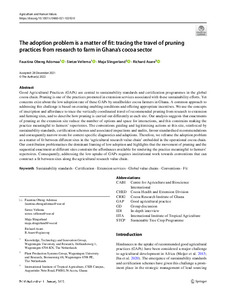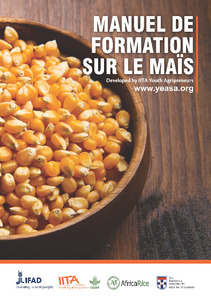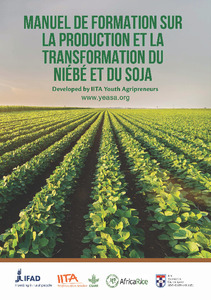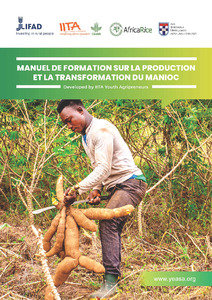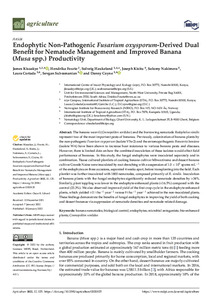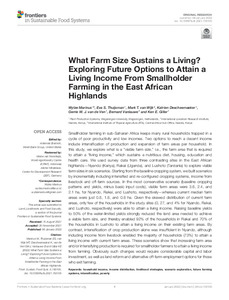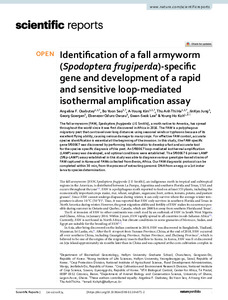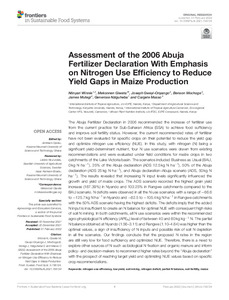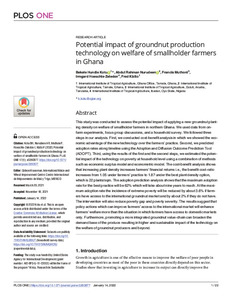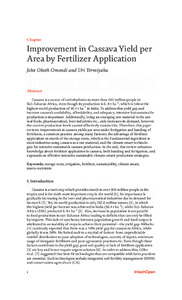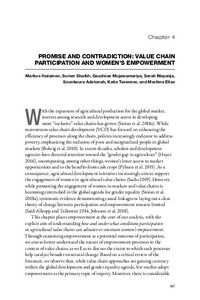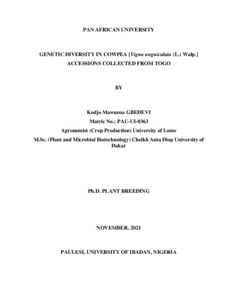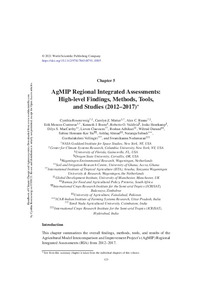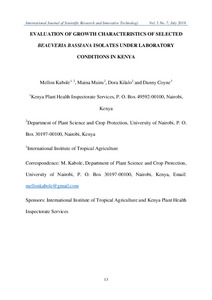Welcome to the International Institute of Tropical Agriculture Research Repository
IITA Bibliography System: Recent submissions
Now showing items 1121-1140 of 7933
-
Effect of phosphorus application on the performance of some cowpea lines
(2021-10-07)Field experiments were conducted for 2 yr (2014 and 2015) in Fashola, southwestern Nigeria, a low-phosphorus (P) environment (approx. 1 mg kg−1), to determine the effect of P application on nutrient uptake, growth parameters, and yield in four cowpea [Vigna unguiculata (L.) Walp.] genotypes (two low-P tolerant and two low P sensitive). Applications were 0 and 30 kg P ha−1 using single super phosphate broadcast on the soil surface just before planting. Phosphorus is very important for leaf and stem ... -
The adoption problem is a matter of fit: tracing the travel of pruning practices from research to farm in Ghana’s cocoa sector.
(2022-01-11)Keywords: Cocoa (Plant) Theobroma Cacao||Farmers||Value Chains||Agricultural Research|| Good Agricultural Practices (GAPs) are central to sustainability standards and certification programmes in the global cocoa chain. Pruning is one of the practices promoted in extension services associated with these sustainability efforts. Yet concerns exist about the low adoption rate of these GAPs by smallholder cocoa farmers in Ghana. A common approach to addressing this challenge is based on creating enabling ... -
Manuel de formation sur le mais
(International Institute of Tropical Agriculture, 2022)Maïs (Zea mays) Le maïs est une culture céréalière qui est largement cultivée dans le monde dans une gamme d’environnements agro-écologiques. Plus de maïs est produit annuellement que tout autre grain. Il existe environ 50 espèces et se composent de différentes couleurs, textures et formes et tailles de grain. Le blanc, le jaune et le rouge sont les types les plus courants. Les variétés blanches et jaunes sont préférées par la plupart des gens selon la région. Le maïs a été introduit en Afrique ... -
Manuel de formation sur la production et la transformation du niébé/soja.
(International Institute of Tropical Agriculture, 2022) -
Manuel de formation sur la production et la transformation du manioc
(International Institute of Tropical Agriculture, 2022) -
Endophytic non-pathogenic Fusarium oxysporum-derived dual benefit for nematode management and improved banana (Musa spp.) productivity
(2022-01-18)The banana weevil (Cosmopolites sordidus) and the burrowing nematode Radopholus similis represent two of the most important pests of bananas. Previously, colonization of banana plants by the non-pathogenic Fusarium oxysporum (isolate V5w2) and the entomopathogenic Beauveria bassiana (isolate WA) have been shown to increase host resistance to various banana pests and diseases. However, there is limited data on how the combined inoculation of these isolates would affect field performance of bananas. ... -
What farm size sustains a living? Exploring future options to attain a living income from smallholder farming in the east African highlands
(2022)Smallholder farming in sub-Saharan Africa keeps many rural households trapped in a cycle of poor productivity and low incomes. Two options to reach a decent income include intensification of production and expansion of farm areas per household. In this study, we explore what is a “viable farm size,” i.e., the farm area that is required to attain a “living income,” which sustains a nutritious diet, housing, education and health care. We used survey data from three contrasting sites in the East ... -
Identification of a fall armyworm (Spodoptera frugiperda)-specific gene and development of a rapid and sensitive loop-mediated isothermal amplification assay
(2022)The fall armyworm [FAW, Spodoptera frugiperda (J E Smith)], a moth native to America, has spread throughout the world since it was first discovered in Africa in 2016. The FAW is a polyphagous migratory pest that can travel over long distances using seasonal winds or typhoons because of its excellent flying ability, causing serious damage to many crops. For effective FAW control, accurate species identification is essential at the beginning of the invasion. In this study, the FAW-specific gene ... -
Assessment of the 2006 Abuja fertilizer declaration with emphasis on nitrogen use efficiency to reduce yield gaps in maize production
(2022)The Abuja Fertilizer Declaration in 2006 recommended the increase of fertilizer use from the current practice for Sub-Saharan Africa (SSA) to achieve food sufficiency and improve soil fertility status. However, the current recommended rates of fertilizer have not been evaluated for specific crops on their potential to reduce the yield gap and optimize nitrogen use efficiency (NUE). In this study, with nitrogen (N) being a significant yield-determinant nutrient, four N use scenarios were drawn from ... -
Selection for resistance to cassava mosaic disease in African cassava germplasm using single nucleotide polymorphism markers
(2022)Cassava mosaic disease (CMD) is one of the main constraints that hamper cassava production. Breeding for varieties that are CMD resistant is a major aim in cassava breeding programmes. However, the use of the conventional approach has its limitations, including a lengthy growth cycle and a low multiplication rate of planting materials. To increase breeding efficiency as well as genetic gain of traits, SNP markers can be used to screen and identify resistant genotypes. The objective of this study ... -
Potential impact of groundnut production technology on welfare of smallholder farmers in Ghana
(2022)This study was conducted to assess the potential impact of applying a new groundnut planting density on welfare of smallholder farmers in northern Ghana. We used data from on-farm experiments, focus group discussions, and a household survey. We followed three steps in our analysis. First, we conducted cost-benefit analysis in which we showed the economic advantage of the new technology over the farmers’ practice. Second, we predicted adoption rates along timeline using the Adoption and Diffusion ... -
Development and scale-up of bioprotectants to keep staple foods safe from aflatoxin contamination in Africa
(Burleigh Dodds Science Publishing Limited, 2022) -
Organic maize and bean farming enhances free-living nematode dynamics in sub-Saharan Africa
(2022-01-03)Despite their important ecological roles for soil health and soil fertility, free-living nematodes (FLN) have received relatively limited research attention. The present study evaluated the community structure and diversity of FLN in a field setting. The experiments were conducted in on-farm and on-station field plots sown to maize (Zea mays) and beans (Phaseolus vulgaris) under four cropping practices. These farming systems included organic (compost and biopesticide use), conventional (synthetic ... -
Improvement in cassava yield per area by fertilizer application
(IntechOpen Limited, 2021)Cassava is a source of carbohydrates to more than 200 million people in Sub-Saharan Africa, even though its production is 6–8 t ha−1, which is below the highest world production of 36.4 t ha−1 in India. To address this yield gap and increase cassava’s availability, affordability, and adequacy, intensive but sustainable production is important. Additionally, being an emerging raw material in the animal feeds, pharmaceutical, beer industries etc., only increases its demand, however the current ... -
Integrating a crop model with a greenhouse gas calculator to identify low carbon agricultural intensification options for smallholder farmers in rural South Africa
(2022-01-22)Models that enable the estimation of crop yields and greenhouse gas (GHG) emissions concurrently are still lacking. This study develops a biophysical modelling framework encompassing a farm typology, a crop model, and a farm-focused GHG calculator to assess productivity (crop yield) and GHG emissions of crop management practices concurrently. Using this modelling framework, the study developed cropping system scenarios based on the concept of conservation agriculture (CA) to identify and design ... -
The potential of stable carbon isotope ratios and leaf temperature as proxies for drought stress in banana under field conditions
(2022)Drought stress is a major limiting factor for banana production and the incidence of drought spells is expected to increase with climate change. Climate smart practices and varieties are needed, but evaluation in the field is hampered by a lack of reliable physiological drought stress indicators. We investigated the potential of using stable carbon isotope ratios (δ13C) and leaf temperature and its derived DANS (Degrees above Non-Stressed Canopy) index as proxies for drought stress in banana. Leaf ... -
Promise and contradiction: value chain participation and women's empowerment
(International Food Policy Research Institute, 2021) -
Genetic diversity in cowpea [Vigna unguiculata (L.) Walp.] accessions collected from Togo
(2021-11)Cowpea is one of the most widely grown legumes in Togo for its grains and leaves, which are used both as food and feed. Despite its importance in the nutrition and economic life of the people, bulk of the varieties grown in Togo are landraces. Genetic improvement of crops requires the presence of heritable genetic variation. However, there is hardly any information on the extent of variability among cultivated cowpea in Togo. This study was carried out to assess the phenotypic and molecular diversity ... -
AgMIP regional integrated asssessments: high-level findings, methods, tools, and studies (2012-2017)*
(World Scientific, 2021) -
Evaluation of growth characteristics of selected beauveria bassiana islolates under laboratory conditions in Kenya
(2018-08)An evaluation of the growth characteristics of nine B. bassiana isolates was conducted under laboratory conditions. Tests for spore concentration, viability, germination percentage, relative hyphal growth and speed of conidial germination were done. Isolate J59 showed the highest spore concentration of 120 and 114.2 spores per ml during the first and second assay respectively. Isolate J57 had the most viable number of spores in both assays. The highest germination percentage of over 80% was recorded ...


